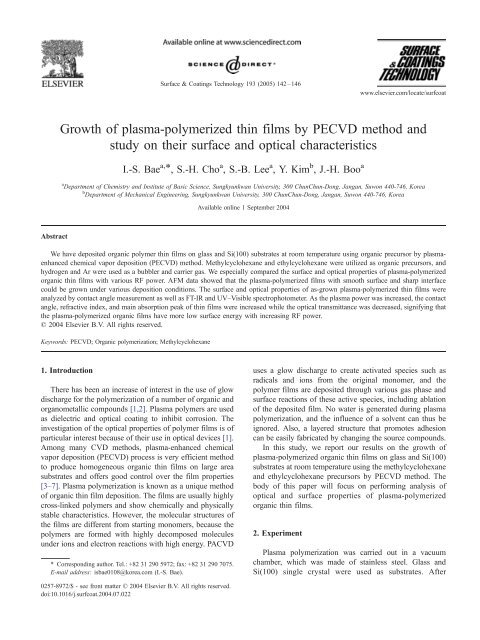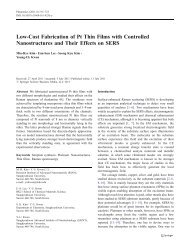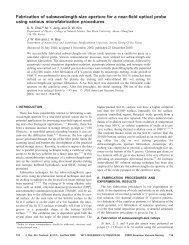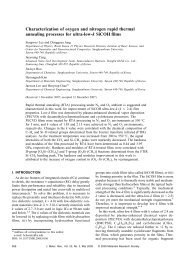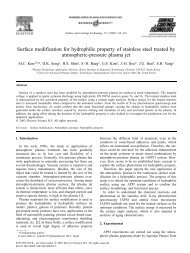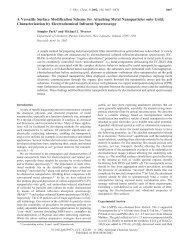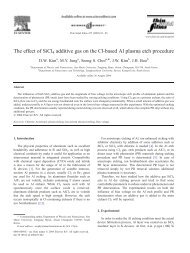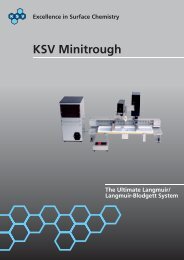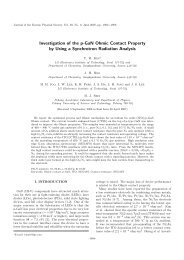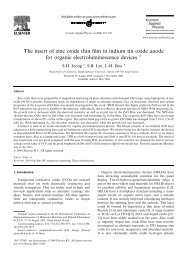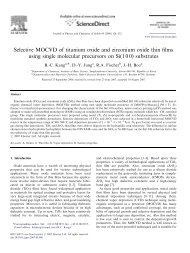Growth of plasma-polymerized thin films by PECVD method and ...
Growth of plasma-polymerized thin films by PECVD method and ...
Growth of plasma-polymerized thin films by PECVD method and ...
You also want an ePaper? Increase the reach of your titles
YUMPU automatically turns print PDFs into web optimized ePapers that Google loves.
Surface & Coatings Technology 193 (2005) 142–146www.elsevier.com/locate/surfcoat<strong>Growth</strong> <strong>of</strong> <strong>plasma</strong>-<strong>polymerized</strong> <strong>thin</strong> <strong>films</strong> <strong>by</strong> <strong>PECVD</strong> <strong>method</strong> <strong>and</strong>study on their surface <strong>and</strong> optical characteristicsI.-S. Bae a, *, S.-H. Cho a , S.-B. Lee a ,Y.Kim b , J.-H. Boo aa Department <strong>of</strong> Chemistry <strong>and</strong> Institute <strong>of</strong> Basic Science, Sungkyunkwan University, 300 ChunChun-Dong, Jangan, Suwon 440-746, Koreab Department <strong>of</strong> Mechanical Engineering, Sungkyunkwan University, 300 ChunChun-Dong, Jangan, Suwon 440-746, KoreaAvailable online 1 September 2004AbstractWe have deposited organic polymer <strong>thin</strong> <strong>films</strong> on glass <strong>and</strong> Si(100) substrates at room temperature using organic precursor <strong>by</strong> <strong>plasma</strong>enhancedchemical vapor deposition (<strong>PECVD</strong>) <strong>method</strong>. Methylcyclohexane <strong>and</strong> ethylcyclohexane were utilized as organic precursors, <strong>and</strong>hydrogen <strong>and</strong> Ar were used as a bubbler <strong>and</strong> carrier gas. We especially compared the surface <strong>and</strong> optical properties <strong>of</strong> <strong>plasma</strong>-<strong>polymerized</strong>organic <strong>thin</strong> <strong>films</strong> with various RF power. AFM data showed that the <strong>plasma</strong>-<strong>polymerized</strong> <strong>films</strong> with smooth surface <strong>and</strong> sharp interfacecould be grown under various deposition conditions. The surface <strong>and</strong> optical properties <strong>of</strong> as-grown <strong>plasma</strong>-<strong>polymerized</strong> <strong>thin</strong> <strong>films</strong> wereanalyzed <strong>by</strong> contact angle measurement as well as FT-IR <strong>and</strong> UV–Visible spectrophotometer. As the <strong>plasma</strong> power was increased, the contactangle, refractive index, <strong>and</strong> main absorption peak <strong>of</strong> <strong>thin</strong> <strong>films</strong> were increased while the optical transmittance was decreased, signifying thatthe <strong>plasma</strong>-<strong>polymerized</strong> organic <strong>films</strong> have more low surface energy with increasing RF power.D 2004 Elsevier B.V. All rights reserved.Keywords: <strong>PECVD</strong>; Organic polymerization; Methylcyclohexane1. IntroductionThere has been an increase <strong>of</strong> interest in the use <strong>of</strong> glowdischarge for the polymerization <strong>of</strong> a number <strong>of</strong> organic <strong>and</strong>organometallic compounds [1,2]. Plasma polymers are usedas dielectric <strong>and</strong> optical coating to inhibit corrosion. Theinvestigation <strong>of</strong> the optical properties <strong>of</strong> polymer <strong>films</strong> is <strong>of</strong>particular interest because <strong>of</strong> their use in optical devices [1].Among many CVD <strong>method</strong>s, <strong>plasma</strong>-enhanced chemicalvapor deposition (<strong>PECVD</strong>) process is very efficient <strong>method</strong>to produce homogeneous organic <strong>thin</strong> <strong>films</strong> on large areasubstrates <strong>and</strong> <strong>of</strong>fers good control over the film properties[3–7]. Plasma polymerization is known as a unique <strong>method</strong><strong>of</strong> organic <strong>thin</strong> film deposition. The <strong>films</strong> are usually highlycross-linked polymers <strong>and</strong> show chemically <strong>and</strong> physicallystable characteristics. However, the molecular structures <strong>of</strong>the <strong>films</strong> are different from starting monomers, because thepolymers are formed with highly decomposed moleculesunder ions <strong>and</strong> electron reactions with high energy. PACVD* Corresponding author. Tel.: +82 31 290 5972; fax: +82 31 290 7075.E-mail address: isbae0108@korea.com (I.-S. Bae).uses a glow discharge to create activated species such asradicals <strong>and</strong> ions from the original monomer, <strong>and</strong> thepolymer <strong>films</strong> are deposited through various gas phase <strong>and</strong>surface reactions <strong>of</strong> these active species, including ablation<strong>of</strong> the deposited film. No water is generated during <strong>plasma</strong>polymerization, <strong>and</strong> the influence <strong>of</strong> a solvent can thus beignored. Also, a layered structure that promotes adhesioncan be easily fabricated <strong>by</strong> changing the source compounds.In this study, we report our results on the growth <strong>of</strong><strong>plasma</strong>-<strong>polymerized</strong> organic <strong>thin</strong> <strong>films</strong> on glass <strong>and</strong> Si(100)substrates at room temperature using the methylcyclohexane<strong>and</strong> ethylcyclohexane precursors <strong>by</strong> <strong>PECVD</strong> <strong>method</strong>. Thebody <strong>of</strong> this paper will focus on performing analysis <strong>of</strong>optical <strong>and</strong> surface properties <strong>of</strong> <strong>plasma</strong>-<strong>polymerized</strong>organic <strong>thin</strong> <strong>films</strong>.2. ExperimentPlasma polymerization was carried out in a vacuumchamber, which was made <strong>of</strong> stainless steel. Glass <strong>and</strong>Si(100) single crystal were used as substrates. After0257-8972/$ - see front matter D 2004 Elsevier B.V. All rights reserved.doi:10.1016/j.surfcoat.2004.07.022
I.-S. Bae et al. / Surface & Coatings Technology 193 (2005) 142–146 143cleaning the substrates using acetone, isopropyl alcohol <strong>and</strong>distilled water, the pre-cleaned substrates were in situ pretreatedwith Ar <strong>plasma</strong> to make an oxygen-free surface <strong>and</strong>/or a buffer layer for enhancing film adhesion. The generaldeposition pressure <strong>and</strong> temperature were 2–410 1 torr<strong>and</strong> room temperature, respectively. The substrates wereheated using indirect heating <strong>method</strong> <strong>and</strong> the temperature <strong>of</strong>the chamber wall was detected <strong>by</strong> Chromel–Alumelthermocouple. The typical conditions <strong>of</strong> <strong>PECVD</strong> processapplied in this study for film deposition are 30–100 W <strong>of</strong> RFpower <strong>and</strong> 20 sccm <strong>of</strong> Ar carrier gas, <strong>and</strong> 20 sccm <strong>of</strong> H 2bubbler gas. Methylcyclohexane <strong>and</strong> ethylcyclohexane wereused as organic precursors. Due to high vapor pressure <strong>of</strong>the precursors themselves, there was no need to heat thesource during deposition. The surface properties <strong>of</strong> asgrown<strong>plasma</strong>-<strong>polymerized</strong> <strong>thin</strong> <strong>films</strong> were analyzed <strong>by</strong>contact angle measurements <strong>and</strong> AFM analysis. The opticalproperties <strong>of</strong> as-grown <strong>plasma</strong>-<strong>polymerized</strong> organic <strong>thin</strong><strong>films</strong> were also ex situ characterized with FT-IR, UV–Visspectroscopy, <strong>and</strong> ellipsometry.3. Results <strong>and</strong> discussionFig. 1a shows FT-IR spectra <strong>of</strong> <strong>plasma</strong>-<strong>polymerized</strong>methylcyclohexane <strong>and</strong> ethylcyclohexane <strong>thin</strong> <strong>films</strong>. InFig. 1a, we can see two strong absorption peaks at about2910 <strong>and</strong> 1400 cm 1 . The absorption peak at 2910 cm 1 canbe assigned to the aliphatic CUH stretching mode <strong>by</strong> methylgroup. And the polymers produce CUH bending modesaround 1400 cm 1 . The small absorption peaks around1400–1600 cm 1 may attribute to CUC <strong>and</strong> CMC stretchingvibration. We could also see the increase <strong>of</strong> absorption peakintensities whenever the polymerization was carried out athigh RF power. Fig. 1b <strong>and</strong> c show UV–Vis transmittancespectra <strong>of</strong> the <strong>plasma</strong>-<strong>polymerized</strong> <strong>thin</strong> <strong>films</strong> that weredeposited at room temperature under the condition <strong>of</strong>Ar:H 2 =1:1 <strong>and</strong> different RF powers. From both figures, wecould see a change <strong>of</strong> optical transmittance in the range 300–350 nm with a sharp slope <strong>and</strong> a high value <strong>of</strong> constanttransmission from 350 to 2500 nm. Higher transmittancethan 80% could be obtained from the methylcyclohexane<strong>films</strong> (see Fig. 1c) grown at RF power <strong>of</strong> below 100 W.However, the optical transmittance was gradually decreasedwith increasing RF powers due a degree <strong>of</strong> CUC orCMCbonding in the film layers. In the case <strong>of</strong> the ethylcyclohexane<strong>films</strong>, on the other h<strong>and</strong>, the optical transmittance wasrelatively lower than that <strong>of</strong> the methylcyclohexane <strong>films</strong>.From these results, we could make the conclusion that wi<strong>thin</strong>creasing RF power <strong>and</strong> number <strong>of</strong> carbon contents in thefunctional group precursor, the optical transmittance <strong>of</strong>organic <strong>thin</strong> <strong>films</strong> decreases. This suggests that wi<strong>thin</strong>creasing RF power, high degree cross-linking density <strong>of</strong>the electrons could be overlapped, resulting in formation <strong>of</strong>more stable polymers. The increase <strong>of</strong> absorption peakintensity with increasing RF power can be explained withFig. 1. (a) FT-IR spectra <strong>of</strong> <strong>plasma</strong>-<strong>polymerized</strong> methylcyclohexane <strong>and</strong>ethylcyclohexane <strong>thin</strong> <strong>films</strong>. UV–visible transmittance spectra obtainedfrom (b) ethylcyclohexane <strong>and</strong> (c) methylcyclohexane <strong>thin</strong> <strong>films</strong> grown onglass at various RF powers.either the increase <strong>of</strong> carbon contents or the scatteredreflection caused <strong>by</strong> <strong>plasma</strong> bombardment. This indicatesthat more high-quality <strong>films</strong> could be deposited using highRF power. Thus, we obtained better crystalline polymer <strong>thin</strong><strong>films</strong> from the condition <strong>of</strong> 100 W RF power.Fig. 2a shows the variation <strong>of</strong> the refractive indexobtained <strong>by</strong> ellipsometry measurements for the <strong>plasma</strong>-
144I.-S. Bae et al. / Surface & Coatings Technology 193 (2005) 142–146Fig. 2. Variations <strong>of</strong> refractive index <strong>and</strong> deposition rate as a function <strong>of</strong> RFpower. (a) Refractive index <strong>and</strong> (b) deposition rate.<strong>polymerized</strong> organic <strong>thin</strong> <strong>films</strong> as a function <strong>of</strong> <strong>plasma</strong>power. As the <strong>plasma</strong> power was increased, the refractiveindex <strong>of</strong> both methylcyclohexane <strong>and</strong> ethylcyclohexane<strong>films</strong> were also increased. However, the refractive index <strong>of</strong>methylcyclohexane <strong>films</strong> has always a higher value thanthose <strong>of</strong> ethylcyclohexane. This means that the polymer-likemethylcyclohexane <strong>thin</strong> <strong>films</strong> have more dense structure <strong>and</strong>the RF power is the main effect <strong>of</strong> enhancing the refractiveindex. This is the same trend as FT-IR <strong>and</strong> UV–Visible data.At this moment, we don’t know in detail why themethylcyclohexane polymer film has high optical refractiveindex <strong>and</strong> transmittance. The increase <strong>of</strong> working temperaturecan also contribute to the increase in the opticalrefractive index <strong>of</strong> <strong>plasma</strong>-<strong>polymerized</strong> organic <strong>thin</strong> <strong>films</strong>.Fig. 2b shows the variation <strong>of</strong> deposition rate with RFpowers. From this figure, we could see that the depositionrates <strong>of</strong> the <strong>films</strong> are linearly increased with RF power, <strong>and</strong>obtain the maximum deposition rates (98 <strong>and</strong> 90 nm/min)when the methylcyclohexane <strong>and</strong> ethylcyclohexane <strong>films</strong>were respectively grown at 100 W <strong>of</strong> RF power. This isquite a higher value compared with that grown <strong>by</strong> theconventional <strong>method</strong>. Increasing the deposition rate wi<strong>thin</strong>creasing RF power can be simply explained in terms <strong>of</strong> theincrease <strong>of</strong> <strong>plasma</strong> density with enough available energywhich could be used for <strong>plasma</strong> polymerization <strong>of</strong>methylcyclohexane <strong>and</strong> ethylcyclohexane precursors. Basedon this assumption, we can underst<strong>and</strong> why the methylcyclohexanefilm has more a dense structure <strong>and</strong> higherdeposition rate, in comparison with the ethylcyclohexanefilm.Fig. 3 shows three-dimensional AFM images <strong>of</strong> the<strong>plasma</strong>-<strong>polymerized</strong> <strong>thin</strong> <strong>films</strong> deposited at RT <strong>and</strong> variousFig. 3. The three-dimensional AFM images <strong>of</strong> (a,b) methylcyclohexane <strong>and</strong> (c,d) ethylcyclohexane <strong>thin</strong> <strong>films</strong> grown on Si(100) with different RF powers.
I.-S. Bae et al. / Surface & Coatings Technology 193 (2005) 142–146 145RF powers. All AFM images showed quite smooth surfaceswith no cracks. In the case <strong>of</strong> the methylcyclohexane film,for example, the rms roughness decreases from 7.375 to0.257 nm with increasing RF power to 100 W (see Fig. 3a<strong>and</strong> b). Moreover, the rms roughness <strong>of</strong> the ethylcyclohexanefilm is also decreased from 7.925 to 0.444 nm wi<strong>thin</strong>creasing RF power. In addition, we could clearly see thecluster on the film surface grown. From Fig. 3a <strong>and</strong> b, wecan see that the clusters <strong>of</strong> the <strong>films</strong> have 1 Am size at 30W<strong>of</strong> RF power. But it was not entirely the cluster from thesurface <strong>of</strong> 100 W. This could be explained <strong>by</strong> the differentdissociation rates <strong>of</strong> precursor or sputtering effect. In otherwords, when the RF power increases, the element <strong>of</strong>precursors goes well disjointing from air or surface. Sothe polymer is formed <strong>by</strong> the size <strong>of</strong> the disjointed element.When the RF power increases, the element size becomessmall because <strong>of</strong> the <strong>plasma</strong> bombardment. We confirmedthat the RF power mainly determines the roughness <strong>of</strong>surface.Fig. 4 shows the variation <strong>of</strong> contact angles <strong>of</strong> the<strong>polymerized</strong> <strong>thin</strong> <strong>films</strong>. Contact angle was measured froma drop <strong>of</strong> liquid resting on a solid surface. The drop <strong>of</strong>liquid forming an angle may be considered as resting inequilibrium <strong>by</strong> balancing the three forces involved. Theangle wi<strong>thin</strong> the liquid phase is known as the contact angleor wetting. In generally, a hydrophilic surface will have acontact angle less than ~708, <strong>and</strong> a hydrophobic surface ischaracterized <strong>by</strong> a contact angle <strong>of</strong> 70–908 or larger. FromFig. 4, the values <strong>of</strong> contact angles for ethylcyclohexane<strong>films</strong> are also increased from 72.98 to 79.38 wi<strong>thin</strong>creasing RF power to 100 W, while those for methylcyclohexane<strong>films</strong> are also increased from 83.08 to 89.38,respectively. This indicates that the <strong>plasma</strong>-<strong>polymerized</strong>methylcyclohexane <strong>films</strong> will relatively have more highsurface energy than that <strong>of</strong> ethylcyclohexane <strong>thin</strong> <strong>films</strong>,<strong>and</strong> both <strong>films</strong> could have hydrophobic surface <strong>and</strong> lowsurface energy with increasing RF power. However, moredetailed experiments are still needed to confine thisphenomenon.4. ConclusionsWe have deposited organic polymer <strong>thin</strong> <strong>films</strong> on Si(100)<strong>and</strong> glass substrates at room temperature using organicmonomer precursors <strong>by</strong> <strong>plasma</strong>-enhanced chemical vapordeposition (<strong>PECVD</strong>) <strong>method</strong>. Radi<strong>of</strong>requency with 13.56MHz was applied for the ignition <strong>of</strong> the <strong>plasma</strong>, <strong>and</strong> theirRF power were changed in the range from 30 to 100 Wunder gas ratio <strong>of</strong> Ar:H 2 =1:1. Methylcyclohexane <strong>and</strong>ethylcyclohexane were utilized as organic precursors, <strong>and</strong>H 2 <strong>and</strong> Ar were used as a bubbler <strong>and</strong> carrier gas,respectively. The as-grown organic <strong>thin</strong> <strong>films</strong> also showedquite high optical transmittance up to 80%. FT-IR <strong>and</strong> UV–Visible results show that the as-grown <strong>films</strong> have someoriented structures. And AFM data show quite smooth <strong>and</strong>dense surface morphology with increasing RF power. Theoptical refractive index <strong>of</strong> methylcyclohexane polymer <strong>films</strong>show more higher value than that <strong>of</strong> ethylcyclohexane <strong>films</strong>while the contact angles <strong>of</strong> methylcyclohexane <strong>films</strong> haverelatively lower values than that <strong>of</strong> ethylcyclohexane <strong>films</strong>,indicating more high surface energy for the methylcyclohexane<strong>films</strong>. The maximum growth rate <strong>of</strong> this study wasfound to be 98 nm/min.Fig. 4. The contact angle <strong>of</strong> the (a,b) methylcyclohexane <strong>and</strong> (c,d) ethylcyclohexane <strong>thin</strong> <strong>films</strong>.
146I.-S. Bae et al. / Surface & Coatings Technology 193 (2005) 142–146AcknowledgmentsThis work was supported in part <strong>by</strong> the BK21 project <strong>of</strong>the Ministry <strong>of</strong> Education, Korea <strong>and</strong> <strong>by</strong> the Center forAdvanced Plasma Surface Technology at the SungkyunkwanUniversity.[2] N. Dilsiz, G. Akovali, Polymer 37 (2) (1996) 333.[3] D. Jung, H. Pang, J.-H. Park, Y.W. Park, Y. Son, Jpn. J. Appl. Phys. 38(1999) L84.[4] J. Joo, Y.C. Quan, D. Jung, J. Mater. Res. 15 (1) (2000) 228.[5] N.V. Bhat, D.S. Wavhal, J. Appl. Polym. Sci. 70 (1998) 203.[6] S. Morita, J. Tamano, S. Hattori, M. Ieda, J. Appl. Phys. 51 (7) (1980)3983.[7] Y.C. Quan, J. Joo, D. Jung, Jpn. J. Appl. Phys. 38 (1999) 1356.References[1] A.B.M. Shah Jalal, S. Ahmed, A.H. Bhuiyan, M. Ibrahim, Thin SolidFilms 288 (1996) 108.


